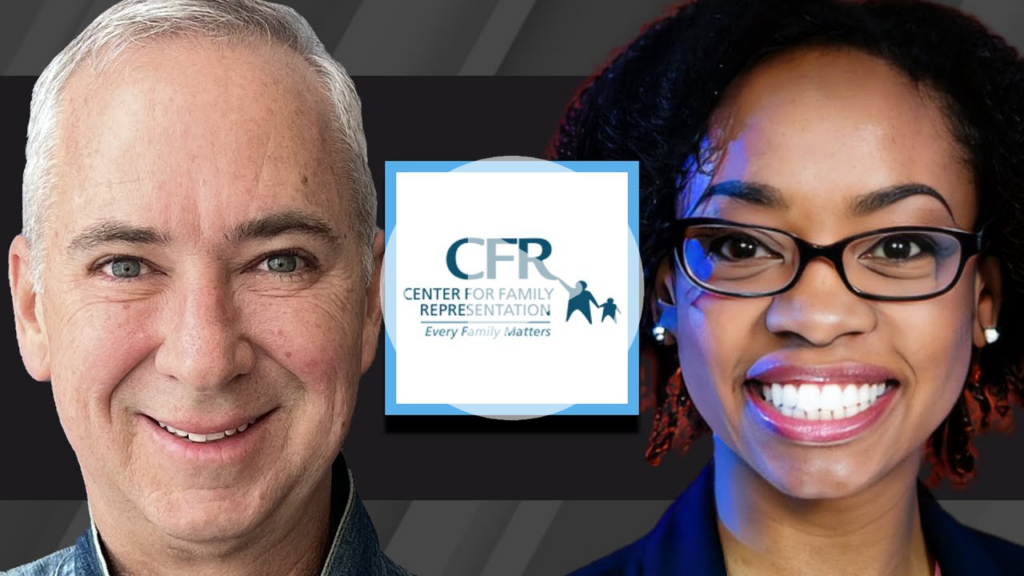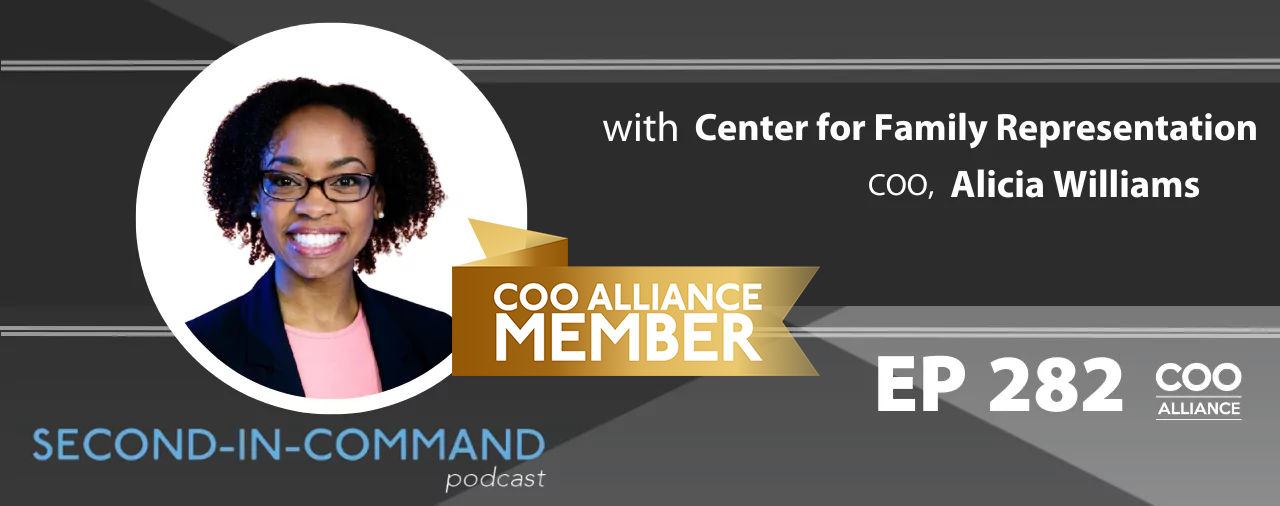Our guest today is COO Alliance Member, Alicia Williams, the Chief Operating Officer of the Center for Family Representation. Alicia oversees CFR’s diversity, equity, inclusion and belonging work, human resources, information technology, and administration activities, and also works closely with our CFO and Executive Director on strategic planning, facilities and operations issues. She has more than two decades of extensive HR experience including diversity, equity and inclusion, labor relations, change management, talent acquisition, and staff engagement. Alicia most recently served as Managing Director of Human Resources at Food & Water Watch, a non-profit environmental organization. She oversaw the strategic direction of their Human Resources department, making sure the work was in alignment with the mission, goals and objectives of the organization. In today’s episode, she and Cameron discuss the challenge of transitioning to report to a new CFO, and the value of taking a step back and using surveys internally to gather more data to ensure that everyone is on the same page.
Share This Episode On:
In This Episode You’ll Learn:
- Being an extroverted CEO vs the more commonly-found introverted COO.
- Lessons learned from implementing a new human resources information system a little too quickly.
- The importance of executing all the time and being intentional with data.
- What senior executives need to do to help executive search firms place them with the right company.
Resources:
Connect with Alicia: Website | LinkedIn
Connect with Cameron: Website | LinkedIn
Get Cameron’s latest book “Second in Command: Unleash the Power of your COO”
Subscribe to our YouTube channel – Second in Command Podcast on YouTube
Get Cameron’s online course: Invest In Your Leaders
—

Watch and Subscribe to our Podcast on Youtube
Get ready to meet the powerhouse behind the Center for Family Representation. This episode features the one and only Alicia Williams, the COO, who’s leading the charge in the fight to keep families together. As the organization’s first-ever COO, Alicia has been instrumental in the growth and success of the CFR. She’s here to share her story with us.
With a passion for people and a knack for leadership, Alicia’s taken on the challenge of transitioning to report to a new COO, and she’s doing it with her trademark energy and enthusiasm. As an extroverted COO, she brings a unique perspective to the role and she’s not afraid to speak her mind and share her ideas.
Even with all her experience, Alicia admits she could have slowed down a bit when executing ideas in her early days as COO. She’s learned the value of taking a step back and using surveys internally to gather more data to ensure that everyone is on the same page. Speaking of data, Alicia knows just how important it is for an organization like CFR to prioritize diversity, equity, and inclusion. It’s a key part of their mission to support families and children in need. Alicia’s leading the charge to make sure that everyone at the CFR feels valued and supported. Grab a cup of coffee and get ready to be inspired by Alicia Williams, the COO of the Center for Family Representation. Also, you can watch the episode on YouTube.
—
Alicia, welcome to the show.
Thank you. It is a pleasure and honor to be here.
I’m looking forward to learning from you and learning more about you as well. I know that you are a COO Alliance member and it’s been intriguing to get to know you a little bit over the last number of months as you have been on a lot of our monthly mastermind calls. Why don’t you start by telling us a little bit about being the COO of the Center for Family Representation, and what the organization does, and then we will go into some of your paths and go deep from there.
I have the pleasure of being the COO of the Center for Family Representation. We are a legal services nonprofit organization based out of New York. We have offices in Manhattan, The Bronx, and Queens. The Bronx is our newest office. Our focus is on keeping families together. We fight those institutional oppressive systems that tend to divide Black and Brown communities in particular.
We provide a full-on interdisciplinary. I will say that as an attorney, a social worker, a family advocate, and a parent advocate. We provide that team to each of our clients who look like me, Black and Brown communities in Manhattan, The Bronx, and Queens. Whether it’s immigration, family, defense, criminal defense, youth defense, or housing, we are there to advocate for them and their rights and combat this system of oppression that they are faced with on a daily basis.
You said something about keeping the families together against this oppression and systems that push against that. Can you give some specifics on what exactly that means to put it in our face?
The ACS, which is the child regulation system that our clients are faced with in New York does enter the lives of these Black and Brown families with this belief that they are guilty. That they are not good parents. They are coming in to save these children from their awful and terrible parents. That is it. They are targeting Black and Brown people. Coming into their lives and destroying these families that very often are doing fine. They are imperfect because maybe they are suffering from poverty or whatever that deficiency is. Many of us struggle as we are trying to do our best to raise our children. That is it. They come into folks’ homes and lives and tear these families apart because they look like me, honestly.

Family Support: Due to the poor child regulation system, black and brown families tend to believe that they are guilty of not being good parents.
I understand. Are you talking about keeping husbands and wives together or is it more about keeping the kids with parents?
Keeping those children with their parents.
It makes a lot of sense. How did you find the organization? You have been there for a couple of years. What was it that attracted you to the organization? What do you think they see in you being the COO or the founding CEO?
I live in Northern Virginia. This organization hired an executive recruiting firm. They found me on LinkedIn, which was interesting and reached out to me for this opportunity. I’m a super spiritual person, so I do believe that all the stars aligned that they were able to consider me from Virginia. In reading the job posting, it was like, “This is me. This is who I am and this is what I do.” This is what I have done in particular as it relates to being a trailblazing position. I am their very first COO. That excited me sure that I would be able to lay down some foundational things in this organization that has been around for years.
I had just gotten my doctorate in education and was looking to put my lived experience to work in a place where I felt like I could bring all of me to work. Through the extensive interview process, the executive search firm, and the many interviews that I had with the staff of CFR at different levels within the organization. Exercises that they put me through. Conversations with my former CEO and CFO. It just felt like there was a strong alignment with who I was and my lived experience.
This organization communicated that they were in these communities. I am very much a mommy first. The mission of keeping families together, I was sold on that mission. Sold on the interaction that my colleagues had with me through the recruitment process. The dynamic alignment that I had with my former CEO. In particular, I was just sold.
What do you think she saw in you especially coming in as the first COO?
I’m sure she felt my energy. She felt my passion. It was funny because she had to leave one of the final interviews and leave me with the CFO. She’s like, “I have FOMO.” It is the energy. The connection. The alignment with who she is as a human. We are soul sisters. I’m sure a lot of it was very much in the connection that we felt in the conversation, our philosophies of how we go about doing our work, occupying spaces, and our passion for diversity, equity, inclusion, and belonging. I know that was probably a big piece of the connection and also my experience, whether it was formally entitled.
I had occupied the role of a COO before in an organization. It had already lived into what was expected of a COO from facilities and IT, communications, customer service, human resources, and training. All of those things were things that I had already tackled in another organization. I know she saw that I brought the toolbox to the table as well.
The matching core values, behavioral traits, and then the skillset. That makes a lot of sense. Coming into an organization as their first COO and coming in over the top of an existing team that was already in the organization, can you walk us through what went well in doing that and what you would have tried to change now having done that?
What went well was my ability to be real. I was unafraid to ask questions to help me understand. I did a lot of listening to understand. Asking questions to get clarification on things. What also went well was my CEO, she prepared the space for this new position as well. It was like I knew I was going to be coming into an already established team. They also knew that they would be getting this external person who would be a part of the team. Her preparation of me for that space was helpful and was done well. Again, it was very often that I found myself saying, “I’m trying to do this dance being me, while also trying to ensure that I’m not upsetting the flow of how things were.”
Oftentimes I see and I would say, “I’m trying to do this dance.” I was able to navigate between my ability to lead a particular way and knowing that CFR and these leaders had led a certain way. For me, the successes would well be pausing, listening, being unafraid to ask questions, and even pushing back sometimes when things maybe didn’t make sense.
What didn’t go well was that I was brought on to make a change. Change is hard. Sometimes when I think about I could have slowed down some of the change and taken off the skates and put on the walking shoes. Some of the changes may have been met with a little bit of resistance. That is something a lesson learned when we are coming into an organization as a change agent to be mindful of how fast we implement that change. That’s continuous to be worked on.
You are one of the first guests out of a couple of episodes who even said that they should have slowed down. It’s very intuitive to know that because too often, COOs and a lot of senior executives come in too quickly. I was working with a CEO and another COO Alliance member on that exact topic. Could you give me 1 or 2 specific examples of where you might have gone too fast?
Before I started, I knew that the HR finance function was operating on a particular platform I had used before, but was very cumbersome and it wasn’t being used to the maximum capacity. There was still a lot of heavy manual entry as a system for the organization. I came on board. I used a particular system at my last job and was fantastic. I implemented and it was phenomenal. This is going to make our work administratively on the backend, so much better. Within probably six months or so, I was engaging an organization, system-wide, human resources, and information system implementation. It is all of those things, quicker, faster, and less manual entry.
What I didn’t do, which I would do if I had to do it over again, was to engage the staff about what was working and not working with the previous system and what they wanted to ensure was maintained in the new system. One of the headaches is like, “The old system gave us this information. This system doesn’t.” If I would have paused and asked, “What is it that you enjoy about this current system?” I’m about to destroy it and get rid of it. You want insurance continued in the new system to make their lives as staff across the organization. That one lesson learned for me is the implementation of that human resources information system out of the gate.
Do you think you bring some of that to the way that you lead now? Do you think you bring some of that by asking questions and understanding more?
Yes. I have my doctorate, so I’m a data person and do research. I love what folks have to say. I was so focused on making the HR administration streamlined and easy at least error-free. That was my focus, which was very narrowly focused. I brought surveys to the organization. I probably drive them crazy because I survey staff on everything, whether it’s a return to the office, a culture survey, or DEIB. One of the things that has become institutionalized since I have been here is the very intentional focus on surveying staff. “What do folks feel about this? What do they care about?” We don’t keep doing the same thing expecting a different result. Let’s ask them. We do a ton of surveys.
I think just in terms of leading, I spend a lot of time saying, “When we are making decisions pause, reflect, and then decide to engage or not.” Oftentimes we just go to engage. “Wait. Let’s just pause here. Take a moment to evaluate what’s happening. Reflect on who am I in this space. How should I engage? What would that look like?” Then decide, “Do I need to engage or do I step back?”
That pause and reflect, engage or not engage, is my MO and I have been teaching folks like, “Let’s think about this. Pause, reflect on what’s happening, and then decide if there’s an engagement or not.” That’s a philosophy that I have been trying to impose upon my workforce. Also, another one of my philosophies as it relates to execution like, “Let’s just do it. Make the decision, execute, live into that, and then tweak it.” We are not set in stone in that decision path.
That’s what I was going to ask about because I was curious about the surveys. Do you ever get the feeling at times you just need to make the decision based on the data that you have got and need to make the call? Do you ever go against the survey like if the survey says X, do you ever go Y?
To answer both of those pieces, I have to execute them all the time. I want to make sure that I’m very intentional about gathering data on process systems that are going to impact this group or that group. I’m going to make sure those voices are there, but ultimately, I have got to decide. It happened in our DEIB work. We were just going around and around and it was like, “This is what we are going to do. We are going to live into this new process and this new way of doing things. Six months, then reevaluate, but we have got to do something different.” That was a very solid piece of where I was just like, “This is not working. We have got to do something different. This is the proposal I have, let’s live into it and then tweak it if we need to as we go along. We have got to start moving this process forward.”
I can just execute. I do a lot related to DEIB. I conducted a survey to evaluate which affinity groups we want to move forward. I’m not going to move them all forward because I don’t have the bandwidth to do that. I don’t have the internal staff who are saying, “Sign me up. I’m going to be the coordinator of that group.” It’s going to be very intentional to groups that I choose to move forward and the ones that I don’t even those surveys, I got interested across a variety of different affinity groups. I don’t have the bandwidth and someone hasn’t raised their hand and said they want to lead it, so we are not moving it forward.
It’s interesting that you said that. You almost read my mind with my question and I’m not necessarily sure how to ask the question. You had mentioned a couple of times about diversity, equity, inclusion, and belonging, and then you even rounded it off as an acronym. I didn’t know there was even an acronym for it. I’m missing an opportunity for growth. My question was how you make decisions that sometimes are tough decisions when it doesn’t necessarily go against those, but it’s also not the Kumbaya group hug. We are not getting everybody together and going, “Let’s all love each other, be happy, and be included.” How many kids do you have?
I have two.
It’s easy when we have two. It’s easy to get the two to pick a restaurant to go to. If you have six kids, somebody is not going to be happy with tonight’s restaurant choice. It can’t just be if the six of you don’t get along. We are not going for dinner because that never works. How do you create those decisions when you are trying to go down? Is it just because diversity, inclusion, and equity are a North Star that you are driving towards, and then tough decisions are a part of that?
We are very intentionally working on a daily basis to be an anti-racist organization. It is not like checking the box. It is not like we have arrived. It is ongoing and never-ending work. We serve Black and Brown communities who are dealing with lots of different oppressive systems. The work that we do internally focuses on how we treat each other and how we deal with disconnects when they show up as they do. For example, I’m on a committee right now in celebration of our AAPI month, which is the month of May. There are twenty of us and we have got to come to a consensus.
I’m the COO in the space and I’m the highest person on this committee that has staff across the organization at various levels. We are doing a lot of decision-making, but I tend to not be the first to voice my perspective because then I don’t want everybody to say, “Alicia said we are going to go to the museum, and so that’s what we are going to do because she’s the COO, she has the power and authority in this space.”
Generally, I am the one who will wait and say, “What feels right? What are you thinking? What about this?” They will say, “I think that that works.” I said, “I was thinking about X.” It’s like, “Okay.” If everybody’s like, “I don’t want to do X.” I’m like, “That’s cool.” I will at least offer my opinion, but I tend to do it at the end so that I’m not clouding the direction that that group wants to take as it relates to the decisions that they want to make about X, Y, or Z.

Family Support: COOs could offer their opinion to the team at the end of a business discussion to avoid clouding the direction that the group wants to take.
The leader has to speak last for the exact reason. We don’t sway. We don’t direct them in the wrong direction. Your path, what’s gotten you to be a COO? What is your journey to get here?
I’m a super spiritual person, so I feel like God is all in it. I started as a bilingual administrative assistant at my alma mater, the University of San Diego in their HR Department, and always my nature is service. I have been a servant. I saw human resources as a way to serve, give back, and help. That was my entry into HR and then in that space, I also became very involved in DEIB and risk management. Earlier on began filling the toolbox with these operational pieces, administration. From there, I moved into an HR role with a wireless communications organization that was focused on human resources and all aspects of HR.
From there became a regional HR manager in a manufacturing environment where I spoke Spanish, which I’m super proud of. I spoke Spanish most of my day. That gave me the opportunity to dig into operations because I was over inside sales windows manufacturing. I would be out on the floor walking around, talking to folks, hard hats, all of that, and oversaw HR administrations and pieces of IT.
From there, I entered the space of nonprofits, which has been my passion since 2005. From there, I became a director of HR and worked in a nonprofit for the largest community action agency in the state of Texas at that point. I had opportunities to continue to grow and fill my toolbox and went from there to a Director of HR for a foundation out in Maryland.
From there, I became the Director of HR training and administration for accreditation. That’s where I was for eight years, where I focused on being second in charge and second in command and filling my toolbox like buying a building, putting in elevators, doing training in HR, and stepping in when my CEO was gone. I was there for eight years and held that second-in-command role even without the title that gave me that bug of like, “I love being able to touch all of these different areas of an organization without having to be in the CEO seat, but being very close to that seat.”

Family Support: Being second-in-command allows you to touch different areas of an organization without being on the CEO seat.
Being able to step in the absence of the CEO, which I did quite a bit in that role. I went as the Managing Director of HR for a nonprofit environmental organization where I was there and created their HR Department similar to what I did at the accreditation organization. I was there for three years and then got picked up by CFR as their first COO where I have been, July 2023 will be two years.
You have got a lot of people’s depth in terms of HR, but it’s not like policies and procedures and dotting the eyes on paperwork culture. It was very much around culture and the people’s side. Plus I love the manufacturing side, not many people get to walk a shop floor with the working blue collar.
It was an assembly line.
Into the nonprofit world and the corporate world’s pretty cool in how you pull all that together. That starts to make a lot of sense. Can you tell us that a lot of COOs get hired via a recruiting agency via executive search firms? We have a couple of partners for the COO Alliance that are amazing executive search firms. What do you think a senior executive needs to do to help the executive search firm place them with the right company? These are a good tool for you as well as someone bringing you over. What do you think makes that a good partnership between the two?
If I think about how I came to be here at CFR, I think the search firm was right for them to listen to Michelle as the former CEO and say, “Wait. I know she’s in Virginia, but I think she may have what we need.” The search firm has to be able to be open to what’s not on the paper. The organization likewise has to be open to, “Do we need them to be five days a week in New York? Could this person possibly do this job in a different way and still meet our needs?” Sometimes as the external search firm, they have their pool of candidates. That’s what they have.
That’s all that they are looking at and that’s who they are trying to push. If the search firm is not in tune with asking questions about, “What is it that you are trying to accomplish in this role?” If you think about the COO role in particular, none of us are alike. There are 140 of us or whatever in the COO Alliance. When I asked the question in the give-get or whatever that was, how many of you oversee DEIB? There are not very many. Our roles are super unique.
For the COO role in particular, it’s very important that the organization understands the gaps that they are trying to fill and put that in the posting so that the executive search firm knows what they are looking for but has to be very intentional about asking good questions about, “What is it that you are looking for in terms for the COO? Are you looking for a partner or for that yin and yang? Are you looking for that person who will help you be better and can be your sounding board?” I’m biased because I got to be here at CFR, but they are posting. It spoke the language that the posting used like a sounding board and partnership. There was tremendous alignment with who I am and what they were asking for too. I don’t know if that answers your question.

Family Support: Business executives must understand the gap they are trying to fill when hiring a COO. Be very intentional about asking good questions.
What’s the number of CFRs? How many employees are there?
One hundred thirty-five.
It’s a good medium-sized organization that is moving to be more of a progressive company if it was not already. Your background and mine because we are both 35. We are from the world where we went to an office, we walked into an office, and all the employees were in the office. We might have had a couple of different offices, but people worked in an office.
I don’t know when people worked from home. It was usually after dinner, but it certainly wasn’t Monday to Friday. How did you make the leap from normal offices to hybrid or remote? How do you make that connection with the whole DEIB as well? How do you bring those four areas into the remote workplace?
In terms of becoming remote, all of us had to flip the switch. We already had laptops, so it was a very easy flip of the switch for us to become an organization that was in the office five days a week to take your laptop and do the work from home. There wasn’t a lot that we had to navigate, and because we are an organization that follows the court flip. We follow the court. We had to immediately flip and align with the court being fully remote. In 2020, I was not here at CFR back then. What I have heard is that it was a pretty easy transition because we already had laptops. The challenge became then how do we still live in this sense of camaraderie and esprit de corps now that we are all over the place and not seeing each other face to face. That has been a challenge.
We are now living into a policy of requiring those staff who are client-facing to be in an office, in person, in court, or the field 2 days a week with the opportunity to work from home up to 3 days as long as the client organizational or colleague needs don’t dictate otherwise. That seemed to have been working quite well. I know in surveying newbies as they have come on board for onboarding, there’s a theme of folks wanting in-person presence more. The connection, the relationships. One of the things that’s connected all of us that’s directly related to our DEIB work is that we have one of the many DEIB committees that we have is focused on celebrations and monthly events.
As I mentioned, we have an AAPI month. Our committee is focused on engaging in a variety of different events and activities and sharing information and resources across the organization. They are going to the Rubin Museum in New York as staff. We do a lot culture-wise. We have monthly events. We have across-the-organization training that all staff are either required to attend or offered to attend to participate and engage. We invite staff across the organization to engage in all of these different ways. It’s not hard for us to live into our DEIB work because we are doing work weekly and monthly, and engaging staff, whether it’s a happy hour or it’s a particular cultural celebration, event, or activity that we offer everyone to participate in.
For Black History Month, we had a movie screening of Madam C.J. Walker, which came on Netflix. We offer that streaming across all of our offices. There’s a lot that we do that brings us together and we offer snacks for people to eat at our staff meetings now, people are invited to come in person or they are virtual. It’s just whatever works with that individual’s lived experience in terms of in-person versus a need to be hybrid as long as they are living to the policy of requiring to be in person two days a week if that’s their job expectation.
It’s hard to go through that process, but you are going through it. You have a very different trait from most COOs and you are very extroverted. You mentioned that you and your prior CEO were both very extroverted. Now you have transitioned a new CEO coming in who’s fairly introverted and you are that extroverted COO. You also mentioned that every COO is completely different. We all have different roles, different responsibilities, and different areas of the business that we run. Can you speak to how you are leveraging your extroversion as a COO?
With my old CEO, it was like, “Do you want to do it or do you want me to do it?” There were things that she enjoyed that were operational that I did. I learned, which is something we as COOs need to do, is live into what they need us as their COOs. Focus on the partnership and ensure that we are complimenting them in whatever way that is. Even if it’s your job, they enjoy doing it. I had to learn with my former CEO that whatever you want to do, that’s fine. If you got it, you got it. That’s cool. With my CEO who is more introverted, I find myself focusing on, “How can I best support you?” I ask her that.

Family Support: COOs must live according to how their CEOs need them to live. They must focus on partnership, complementing their executives in whatever way that is.
There are situations where I’m like, “Do you want me to lead in this space or do you have it?” There has been a focus on not wanting to have as many meetings. That is something that she is bringing in her new capacity. “Which meetings can we get rid of?” I’m like, “Right on.” What can we do to streamline some of these in-person conversations that could be handled via email or something like that? How I am trying to support her, whether I am an extrovert or an introvert is asking, “What do you need from me? How can I best support you?”
Whatever that looks like, if you need me to be more extroverted in this space, I got it. I can lead. If you need me to take a backseat and you got it, I think that that’s just how I roll. I don’t know if it’s me particularly living into an extroversion or an introversion, it is just what does support look like to you? That’s what matters to me.
What was it you were looking for when you joined the COO Alliance? What was it that grabbed you and said, “Yes, I should join?”
I think I was considering another C-Suite organization at the time and wanted to find a space to process how unique, challenging, and dynamic the work of a COO was. Why I chose COO Alliance over that other organization because I love diversity. There are men, women, and ethnicities across the COO Alliance. Different countries are represented, with different perspectives, different industries, and different backgrounds.
I have gone to each of our monthly mastermind sessions and I would have to say I didn’t anticipate all that has come with this membership. It’s been overwhelming and fantastic. It’s interesting because my former CEO who is very much an ops person texted me and I was telling her about this conversation and she’s like, “I may join the COO Alliance if I get a COO.”
I said, “Yes. You are the one that gave me the approval to be here in the first place.” It’s been more than I anticipated from the onboarding process to all of the beautiful gifts and books that help add to our repertoire and conversations that we can have and sharing of resources. I do appreciate that it’s not about my opinion, but it’s about my experience. That lens is very helpful. I don’t have all the answers. I have my experience, which I can share, but I’m not an expert. We can share and collectively be able to share our lived experiences.
Bunch of monthly mastermind speakers too. We have got some incredible speakers coming in. Last question. I want you to give yourself the 22-year-old Alicia Williams some advice. If you were to lean back to when you were 22 years old and you wanted to give yourself some advice, maybe it’s advice that you know to be true now, but you wish you’d known back then. What would you tell yourself?
I would tell my 22-year-old, fantastic self, be your genuine and authentic self. Be unafraid, be bold, be brave, and know you have everything that you need already inside you.
Alicia Williams, the COO of the Center for Family Representation. Thanks so much for sharing.
Thank you.
That was awesome. I appreciate it.
Important Links
- Center for Family Representation
- YouTube – Second In Command Podcast with Cameron Herold





